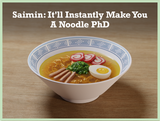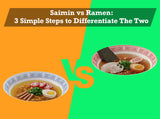
Answer: Noodles loose chewiness, texture, and flavor because too much water content has been absorbed into the noodles.
Do you know what really happens inside the noodles?
Keep reading and you will find out!
One day, I went to a ramen shop with my Canadian wife and her friends...
Do you know what really happens inside the noodles?
Keep reading and you will find out!
One day, I went to a ramen shop with my Canadian wife and her friends...

Few minutes after we placed the order...

My ramen was served.

I was thinking...
"I should eat this ramen as soon as possible because my ramen will get soggy."
But unlike in Japan, I could not start eating right away.
Why not?
In Japan, in a situation like this, the person who is still waiting for his or her ramen will say something like...
"You should start eating right now otherwise your ramen will get soggy."
And you say,
And you say,
“Then, excuse me."
And you start eating first.
I was waiting for somebody to say something like that.
But no one did.
I was like...
And you start eating first.
I was waiting for somebody to say something like that.
But no one did.
I was like...

I was getting impatient inside, but I should be polite.

My wife and her friends were chatting away happily ...
HELLO! GUYS! (My inside voice)
HELLO! GUYS! (My inside voice)

I decided to keep my mind zen... but I regretted a lot that I had waited until everyone else’s ramen was also served.

Since then, I decided I will start eating my ramen without waiting for others' to be served.
Do you know the reason why ramen gets soggy?
Here are reasons why:
Do you know the reason why ramen gets soggy?
Here are reasons why:
Reason 1: The core of noodles
The ideal condition of ramen noodle is having different texture between the surface of the noodle and the core of the noodle.
The surface has more water, so it is slippery.
But the core of the noodle is firm.
This is what gives ramen noodles its distinct texture.
The surface has more water, so it is slippery.
But the core of the noodle is firm.
This is what gives ramen noodles its distinct texture.
And this is the reason why you find ramen noodles yummy.
When noodles absorb too much water, water reaches into the core of noodles.
The surface of the noodles and core of noodles have the same texture.
When noodles absorb too much water, water reaches into the core of noodles.
The surface of the noodles and core of noodles have the same texture.

Noodles lose its texture, and it becomes fragile and will break easily.
Reason 2: Gluten
Do you know the reason why good ramen noodles have firm texture?
Here is the reason why...
When you make ramen dough, you mix wheat flour with kansui.
During this process, glutenin and glidianin from flour bond together, and turns into gluten.
This gluten has stickiness and a distinct bounciness to it.
Structure of gluten is similar to a jungle gym.
Here is the reason why...
When you make ramen dough, you mix wheat flour with kansui.
During this process, glutenin and glidianin from flour bond together, and turns into gluten.
This gluten has stickiness and a distinct bounciness to it.
Structure of gluten is similar to a jungle gym.

It is like a three denominational fishing net and it works like a reinforcing bar for a skyscraper.
When you boil noodles in a pot, starch in the noodles absorb water and this starch tend to expand.
When you boil noodles in a pot, starch in the noodles absorb water and this starch tend to expand.

While starch is expanding, gluten tries to prevent the starch from expanding out of its frame.
However, if you soak your noodles too much, the expanding starch breaks the gluten frames.
The frames cannot win against expanding starch because 70% of noodles is made of starch.
And thus, noodles gets soggy.
You might think...
"Okay, but the reason why raw noodles become edible is because of its ability to absorb water, so why is this a bad thing?"

Yes, you are right.
Noodles absorbing water is the process of your noodles getting good texture, and chewiness.
But it is difficult for you to control and stop noodles from getting soggy.
Because it is a continuous transformation.
You might think...
"Can I bring soggy noodles back to its original condition/status?"
Unfortunately, you can't do that.
Noodles getting soggy means the jungle gym structure is already broken.
Once it happens, you cannot build this structure again.
Good news:
Do you want to know how to avoid soggy noodles?
Here are some solutions...
Do you want to know how to avoid soggy noodles?
Here are some solutions...
Solution 1: Eat quickly
Ramen is meant to be eaten quickly.

Before your soup gets cold and noodles get soggy, finish your ramen.

Before your soup gets cold and noodles get soggy, finish your ramen.
Solution 2: Separate noodles and soup
The reason why noodles get soggy is because noodles absorb too much water.
You can prevent that by separating noodles and soup to prolong the longevity of the noodles.
You can prevent that by separating noodles and soup to prolong the longevity of the noodles.

It works for sure, but still, eating fresh ramen is the best!
Solution 3: Temperature control (the best solution)
In order to prevent your noodles from getting soggy, you need to heat your ramen bowl up.
It sounds complicated.
Right?
But it is actually very simple.
It is just pouring boiling hot water into your ramen bowl.
And keep the hot water in there right before serving soup and noodles.
And keep the hot water in there right before serving soup and noodles.
You know what?
Whether your noodles get soggy or not, depends on the temperature of the soup.
You need to keep your soup hot by heating up your ramen bowl.
Pro tip:
When you boil water in a pot for your noodles, boil a bit of extra water.
After bringing the water to a boil, pour the extra water into your ramen bowl.

And start cooking noodles in the pot.
You probably have seen this but...
There are a lot of ramen restaurants that heat their ramen bowl up before serving.
Soggy noodles... it is the saddest thing ever that happens.
You should avoid this problem by heating up your ramen bowls.
You don't have ramen bowls to heat up?
Don't worry, check out some of our favourites!
11 Crucial Differences Everyone Should Know: Ramen vs. Pasta



Hi Marcos – I’m glad you enjoyed reading my article!
Congratulations for who wrote this magnificent explanation! I’ve never read anything so well detailed in such a short text!
Leave a comment